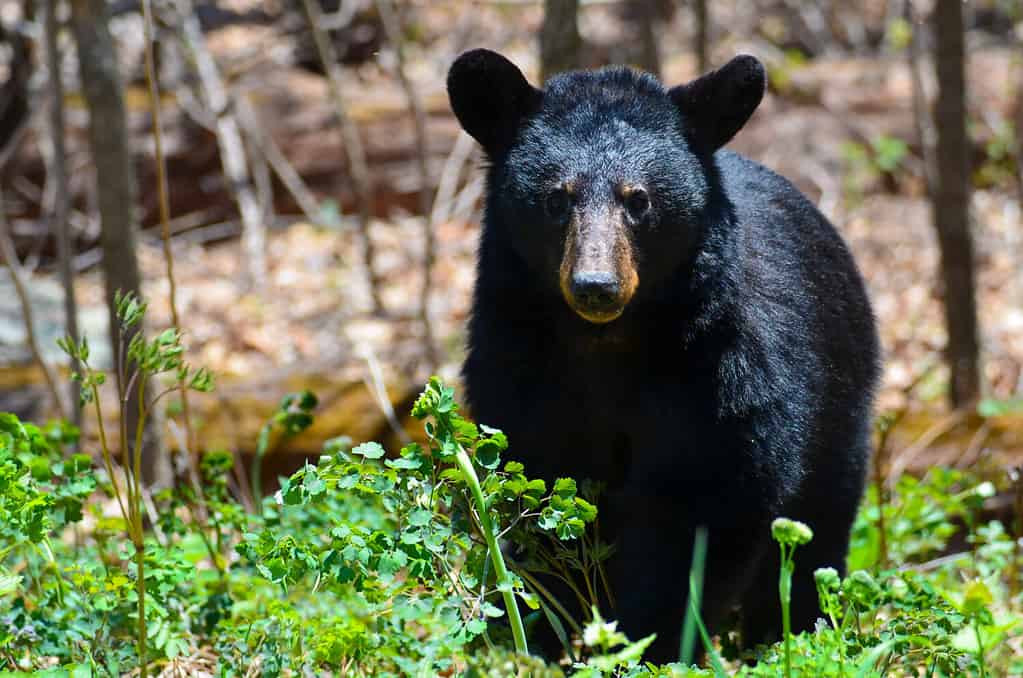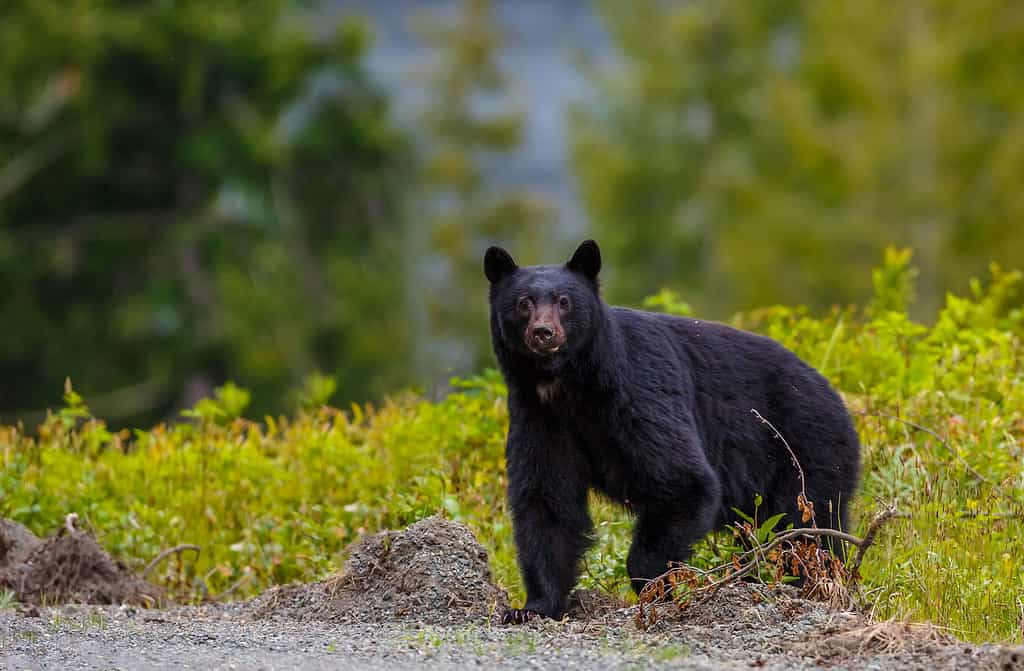The uppermost state of the contiguous United States and one of the most iconic places of the Pacific Northwest — Washington State — has a diverse wildlife population that includes the mighty black bear. From Seattle to Spokane and every mile in between, black bears roam the forests and grow up to nearly 600 pounds.
The Evergreen State gets its nickname honestly: Washington is home to over 22.5 million forested acres. That amount of forested land makes up half the state’s area and tallies nearly 9.4 billion live trees. With so much wilderness to explore, a plethora of wildlife make their home in the Washington wilderness. black bears find their homes within the trees, brush, and dens of the woods — hunting prey in droves before hibernating to withstand the PNW’s frigid winters.
Among the species of bear, black bears rank dead middle for size. Brown bears and Short-Faced Bears are much smaller, while a Polar Bear and a Kodiak would tower over the black bear. Still, these creatures remain significantly larger than humans, and hunting the largest is a prize to behold.
In 2001, a hunter felled the biggest black bear Washington has on record for hunting. Do you know how large the largest black bear ever caught in Washington was? Keep reading to learn more about this forest behemoth.
Black Bears: A Keystone Species in Washington

American black bears germinate the seed and fruit plants they eat with their scat, adding to the biodiversity of the ecosystem.
©Orhan Cam/Shutterstock.com
Over 25,000 black bears roam Washington’s ecosystem, playing a large and important role in the ecological spaces. These bears are exclusively found in North America and are the only living bear species to have evolved here. Did you know that the main function of black bears in the ecosystem was a germinator, like a bee? That’s right — berry seeds pass through these bears unbroken through feces, which acts as a fertilizer, and germinates the berry seeds into new bushes across Washington State.
Washington State black bears remain similar to all other American black bears: they choose habitats in rainforests, woodlands, and greenbelts with thick forested areas and an endless supply of fruit and nut-bearing shrubs. The diet of a Black Bear does vary greatly; depending on where the Black Bear lives, it will become more of an omnivore or carnivore based on the availability of food.
As of July 2023, the American black bear’s conservation status is “Least Concern.” The populations in the wild thrive among the many acres of habitat in Washington State, as well as the rest of the nation. And, because black bears sit near the top of the food chain, most of the population control and worry comes from human interference. Still, bear hunting season regulations preclude avid outdoorsmen from hunting more than two black bears in a year. However, the Washington Department of Fish and Wildlife website does state that a property owner can kill a bear if it is damaging crops or domestic animals — or if it poses a significant, imminent risk to human life.

The Legend of Forest Behemoth
Since humans came to Washington State, black bears have made appearances around or near their settlements. Black bears will leave the safety and comfort of the forest in search of food if they’re hungry — resulting in the encroaching human populations on bear habitat having a greater chance of encountering each other. With their super-sensitive nose, black bears can track available food for miles. Black bears are also wicked smart; some ursinologists have found black bears that memorize where garbage cans are located and learn the days and routes used by garbage haulers. Viral videos of bears rooting through trash bins at log cabins are most likely footage of black bears; they’re not as scared of humans as they are hungry and will push the limits of themselves and humans to get their next best meal.
Black bears will bulk up their body weight in the fall to prepare for hibernation — meaning the biggest black bears spotted in these months may not indicate the bear’s weight most of the year. However, bear hunting season falls in autumn (between August 1 and November 15) in Washington State, so the hunt for the state’s largest black bear remains. For over 20 years, no one has been able to unseat the current record holder.
As an aside about bear hunting season: the state of Washington does impose a few regulations on bear hunting, including submitting the first pre-canine molar to the Washington Department of Fish & Wildlife and avoiding mother bears and their cubs. Finally, hunters should have a clear identification of the black bear, as mistaking it for a Grizzly will not excuse the repercussions of hunting and killing the latter — a state- and federally-protected animal.
The Record-Breaking Capture

The largest black bear hunted was killed in 2001 in Spokane, Washington.
©Menno Schaefer/Shutterstock.com
According to the Boone and Crockett Club, the preeminent report on big game trophy hunting, one hunter has outlasted every other when hunting black bear in Washington.
On August 6, 2001, Lars C. Swartling killed a bear in Spokane, Washington that measured a massive 13 and 9/16 at its greatest length and 8 and 3/16 at its greatest width. These measurements give it a total average score of 21 and 12/16: solidifying it as the top game trophy for black bears in the state. Runner-ups for the largest black bear killed in Washington State include:
- Robin L. Radach with a score of 21 and 10/16 in 1999.
- Jason E. Johnson with a score of 21 and 8/16 in 2021.
- T. Johnson and B. Paque in 1968 and Kyle N. Aselton in 2016 with a score of 21 and 7/16.
- Bert Klineburger with a score of 21 and 5/16 in 1963.
Hunters that fell a black bear must have a valid Big Game license, carry a tag with them, and have a way to transport the kill to and from the hunting grounds.
Understanding Black Bear Behavior
Overall, black bears are curious animals not intimidated by much. One of the most interesting facts about black bears is that they don’t technically “hibernate” in the truest sense of the word. Instead, black bears participate in “denning,” or a period of reduced activity over the winter months. In warmer climates, like in Florida, black bears sleep less deeply than their Northern counterparts — so your chances of “waking a sleeping bear” are even more apt to occur!
As omnivores, black bears eat berries, plants, and meat. However, some estimations believe meat only makes up a small percentage of their diets: less than 10%. After their hibernation period in the winter, black bears may prey on young deer and elk, or approach the carcass of an animal felled by another predator (like a mountain lion) to see if any meat is left.
Black bears reproduce every few years to help their young grow strong and venture out on their own. Cubs usually reared in litters between two and six, are born blind and without teeth, so they rely on their mother to get nutrients by nursing. Once the hibernation season ends, they’ll follow their mother for two to three years and learn how to hunt on their own. Once grown, black bears live up to 30 years.
Black Bears and the Washington Ecosystem

Cubs live with their mother until they can learn to hunt and exist in the ecosystem themselves.
©Critterbiz/Shutterstock.com
Black bears are mostly solitary creatures unless they’re a mother raising young cubs. The main activity they involve themselves in is hunting for food — whether that’s eating berries or finding small animals and fish.
As mentioned above, black bears germinate the Washington forests with their scat. Nut and berry seeds pass through a black bear’s digestion system without breaking down — meaning when the bear leaves a mark, the seeds can take root immediately.
Unlike wolves or foxes, bears aren’t naturally territorial. They will protect cubs and mates if immediately present; if not, the bear won’t become overly aggressive if or when another animal encroaches on their territory. Instead, their curiosity will investigate anything new in their area — or they’ll simply leave.
While not technically an apex predator, the black bear has very few predators in the wild — especially depending on the locale. For example, the mountain lions in Washington and Canada that prey upon the smaller black bear and their cubs may not be the predators of black bears in Florida. Among the other predators of black bears are packs of wolves and coyotes, bobcats, grizzly bears, and humans.
Challenges of Bear Conservation in Washington
Flashes of The Revenant come to mind when thinking about human-black bear encounters in the wild. However, these situations happen few and far between. When they do, it’s almost always because a black bear is lost or smelled food and came to investigate for themselves. The most recent account of a black bear attack in Washington State was in 2022 when a woman taking out her dog was confronted by a large sow. After punching the bear in the nose, the woman escaped and was treated for her non-life-threatening injuries. The Washington Department of Fish & Wildlife did end up tracking down the bear and killing it. The department rescued its two cubs and sent them to a rehabilitation facility.
The black bear population in Washington State is of Least Concern on the international conservation scale, so the only regulations that exist center on hunting rules and guidelines. For the most part, bear conservation efforts focus on the human-wildlife conflict: balancing safety and preservation.
Public awareness and education remain one of the priorities of wildlife agencies. Information about managing garbage well, not feeding or approaching bear cubs in the wild, and securing food during camping trips range among the most important lessons taught.
By arming residents and visitors with the best practices of living, working, and playing in bear country, the Washington Department of Fish & Wildlife hopes to create a safe, symbiotic environment for both bears and humans.
A Testament to Washington’s Wilderness
Black bears play a significant role in the ecosystem of Washington State. The bears’ massive size compared to humans makes them enticing prey for hunters, with the largest ever catching a 21 and 12/16 score.
As humans continue to develop the forested land in Washington, black bear encounters may become more common. Avid “foodies” that will travel to track the scent of a meal, black bears have frequented trash cans and dumpsters of homes and businesses. Some researchers have experienced individual bears using their intelligence to predict the next time a meal will come along in that same spot.
The photo featured at the top of this post is © Constance Mahoney/Shutterstock.com
Thank you for reading! Have some feedback for us? Contact the AZ Animals editorial team.







